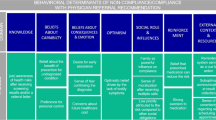Abstract
The contents of 200 letters of referrals from physicians to a clinical obesity unit were compared with patient-reported data and analysed for concordant and discordant information. For major comorbidities (diabetes, hypertension, joint problems) concordant information was found in about 80%, whereas discordant information was found in 46% for smoking, and 66% for medication. Forty-five percent of psychological problems, described by patients, were not identified by the referring physician. The role of the referral letter as a tool in medical communication has received little attention and comparative data are generally lacking, but our data suggests that there is room for considerable improvement of the quality of the referral letter.
This is a preview of subscription content, access via your institution
Access options
Subscribe to this journal
Receive 12 print issues and online access
$259.00 per year
only $21.58 per issue
Buy this article
- Purchase on Springer Link
- Instant access to full article PDF
Prices may be subject to local taxes which are calculated during checkout
Similar content being viewed by others
References
Linné Y, Rössner S . What is ‘obesity’—an analysis of referral letters to an obesity unit Int J Obes Relat Metab Disord 1998 22: 1231–1233.
Emmanuel J, Walter N . Referrals from general practice to hospital out patients department; a strategy for improvement BMJ 1989 299: 722–724.
Jenkins S, Arroll B, Hawkin S, Nicholson R . Referral letters: are form letters better? Br J Gen Pract 1997 47: 107–108.
Epstein O . The transformation of letter writing with information technology Br J Hosp Med 1989 41: 177–181.
Pullen IM, Yellowlees AJ . Is communication improving between general practitioners and psychiatrists? BMJ 1985 290: 31–33.
Rand CS, Macgregor AM . Morbidly obese patients' perceptions of social discrimination before and after surgery for obesity. South Med J 1990 83: 1390–1395.
Coomber C, Finer N, Peterson D . Quality of referrals to an obesity clinic Int J Obes Relat Metab Disord 1997 21 (Suppl 2): S114.
Author information
Authors and Affiliations
Corresponding author
Rights and permissions
About this article
Cite this article
Linné, Y., Rössner, S. Referral letters to an obesity unit—relationship between doctor and patient information. Int J Obes 24, 1379–1380 (2000). https://doi.org/10.1038/sj.ijo.0801391
Received:
Revised:
Accepted:
Published:
Issue Date:
DOI: https://doi.org/10.1038/sj.ijo.0801391
Keywords
This article is cited by
-
Success rate of Orlistat in primary-care practice is limited by failure to follow prescribing recommendations: the referral letter content vs clinical reality
International Journal of Obesity (2003)


